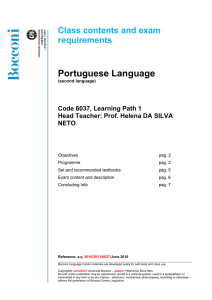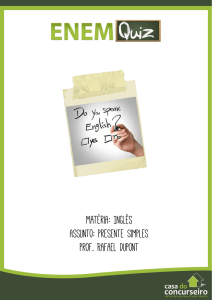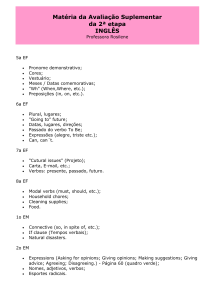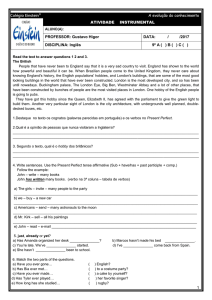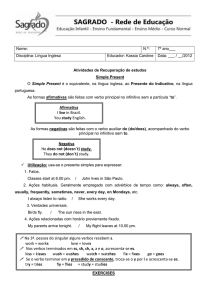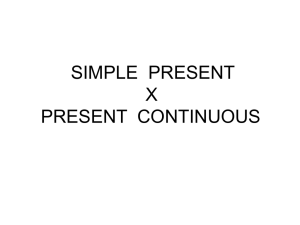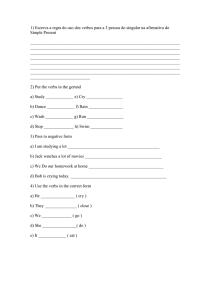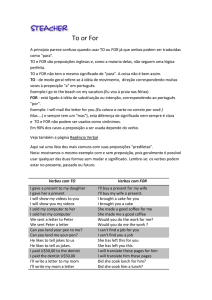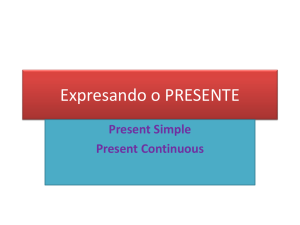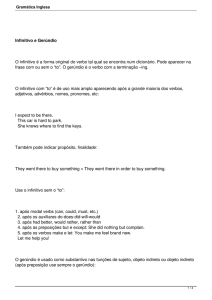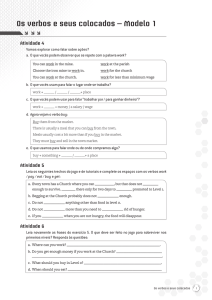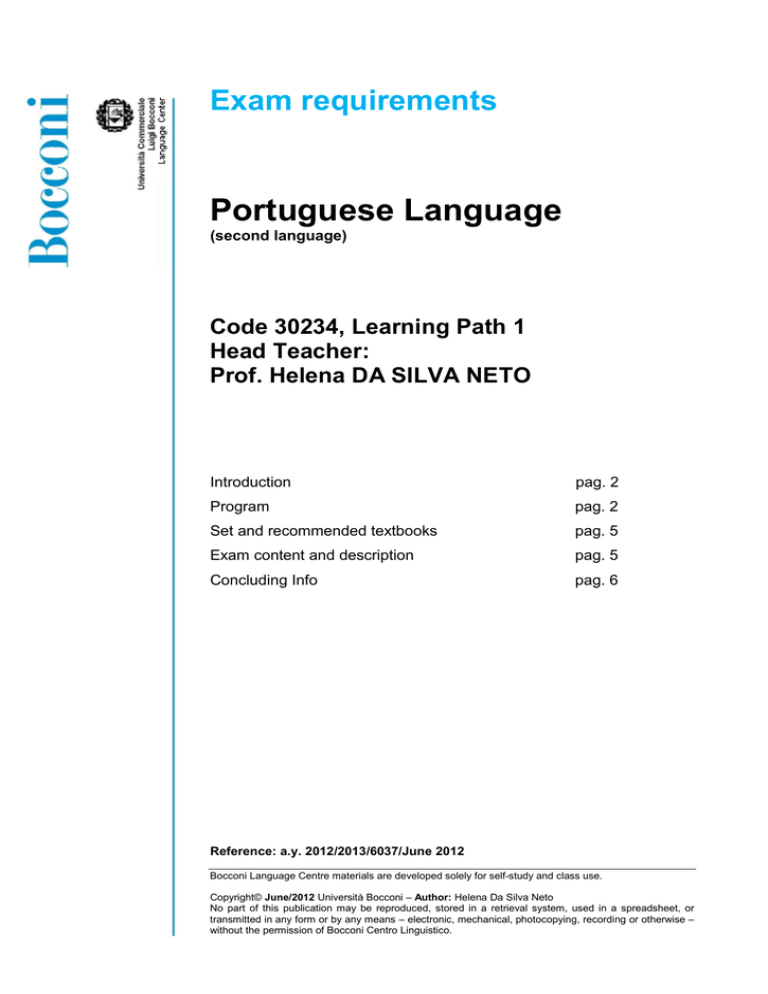
Exam requirements
Portuguese Language
(second language)
Code 30234, Learning Path 1
Head Teacher:
Prof. Helena DA SILVA NETO
Introduction
pag. 2
Program
pag. 2
Set and recommended textbooks
pag. 5
Exam content and description
pag. 5
Concluding Info
pag. 6
Reference: a.y. 2012/2013/6037/June 2012
Bocconi Language Centre materials are developed solely for self-study and class use.
Copyright© June/2012 Università Bocconi – Author: Helena Da Silva Neto
No part of this publication may be reproduced, stored in a retrieval system, used in a spreadsheet, or
transmitted in any form or by any means – electronic, mechanical, photocopying, recording or otherwise –
without the permission of Bocconi Centro Linguistico.
Portuguese Learning Path - Code 30234
a.y. 2012/2013/30234/June 2012
PORTUGUESE AS SECOND FOREIGN LANGUAGE
Please remind that the Portuguese learning path will focus on the European standard
(Portuguese spoken in Portugal), even if there will be constant hints to the Brazilian and African
linguistic rules, in order to show students the main differences among the three varieties of
Portuguese.
At the end of the program, students should be able to understand the Brazilian/African educated
speech and recognize the differences in the pronunciation.
Please remind that no classes are run for Portuguese as a foreign language. Students who have
included Portuguese in their study plan can sit for the Bocconi exam until December 2012.
Starting from this date it will be only possible to register in the study plan one of the international
certifications recognized by the Language Centre.
Program
The course book (Olá! Como está?) puts in comparison the European and Brazilian varieties, both
in oral and written texts.
Therefore, during the exam students may be faced with texts (oral and written) referring to these
three varieties of Portuguese.
Topics
Apresentar-se
Cumprimentar
Países Lusófonos
O alfabeto, ditongos e outros sons específicos do
Português
Unit 0
Gostos
Ocupações e
actividades
Desportos
Línguas
Meios de transporte
Dias da semana
Género e número dos substantivos
Artigos definidos e indefinidos
Presente do Indicativo em–AR (chamar-se, morar,
trabalhar, apanhar, viajar, gostar, detestar, fumar,
praticar, cantar, tocar, adorar, jogar)
Forma interrogativa e negativa
“Como está? / Como estás?”
Expressões interrogativas
Preposições de tempo
Presente do Indicativo (Verbos regulares) em –ER
(viver, conhecer, escrever, comer, beber, perceber,
ler)
Determinativos possessivos
Artigos definidos + Locuções de lugar
Preposição “em” e contracção com os artigos
definidos e indefinidos
Pronomes interrogativos “Que”: “que + nome”,
“que+verbo”, “o que è que+(pronome)+verbo”, “o
que+verbo”
Uso de “Muito, muita, muitos, muitas”; “muito +
adjectivo”, “muito + adverbio”, “verbo + muito”
Presente do Indicativo (Verbos
regulares/irregulares) em –IR (preferir, partir, dormir
discutir, conduzir, dirigir - servir, subir): “Ir +
Infinitivo” (futuro próximo); “Precisar de + Infinitivo”,
“Começar a + Infinitivo”, “Dever+ infinitivo”
Preposição “de” e contracção com os artigos
definidos e indefinidos
(+ nomes de lugares)
Preposições de movimento
Unit 1
“Bom dia”
(pp.33-44)
Self-study
program
L.T*.: pp.1923
L.A.**: pp.9
CD/unità 0
CD/unit 1
L.A.: pp. 1117
Unit 2
“Onde Vive”
(pp.45-55)
CD/unit 2
L.A.: pp. 1926
Unit 3
“Boa
viagem!”
(pp.57-67)
CD/unit 3
L.A.: pp. 2734
Família
Países
Bebidas
Tempos livres
Partes do dia
No hotel
Refeições
Meses do ano
Numerais ordinais
Grammar
Units
2
Portuguese Learning Path - Code 30234
Rotina diária Pequenoalmoço
Movimentações
Banco
Descrição física
Profissões
Estado Civil
Nacionalidades
Estações do ano
Climas
Cores
Horas
Actividades recreativas
Estado do tempo
Compartimentos da
casa
Fazer compras
Lojas (na sapataria,
pastelaria)
Nos correios
No aeroporto
Tráfego na cidade
No hotel
Na rua
a.y. 2012/2013/30234/June 2012
Verbos reflexivos (presente do Indicativo): “sentarse, levantar-se, lavar-se, vestir-se, calçar-se,
aproximar-se, despedir-se, encontrar-se”
Posição do pronome reflexo na frase
Verbos “fazer” e “ir” (Presente do Indicativo)
“Ir + Infinitivo” (Futuro próximo)
“Pretérito Perfeito do Indicativo” (verbos regulares
em –AR / -ER / - IR
Preposição “de” e contracção com os artigos
definidos e indefinidos
(+ nomes de lugares)
Pronomes de complemento “lhe / lhes”
Pronomes indefinidos
Verbos “ser / ter/ ser de / chamar-se / morar (em) /
falar”
Adjectivos: concordância. Posição na frase, graus
Advérbios de intensidade
Graus dos advérbios
“Pretérito Imperfeito do Indicativo” ( verbos
regulares em –AR / -ER / - IR )
Imperativo afirmativo (com Presente do Indicativo)
Verbo “estar” (Presente do Indicativo)
“Estar a + Infinitivo / Gerúndio”
Locuções prepositivas
Preposições “Com + pronomes pessoais
Partícula pronominal se
Verbos “pôr, ver, poder” (Presente do Indicativo)
“Pretérito Imperfeito do Indicativo” (verbos regulares
em –AR / -ER / - IR
Pronomes Determinativos e demonstrativos
Preposições “em, de, a” + demonstrativos
Formação do Plural (nomes em al /el /il /ol /ul +
ão)
Diminutivos
Verbos “sair, dizer, vir, trazer, ler, saber, dar”
(Presente do Indicativo)
Dupla negativa
Perífrases verbais: “Acabar de + Infinitivo” (passado
recente)
Preposições “para / por”
Imperativo afirmativo e negativo
“Pretérito perfeito simples do Indicativo” (verbos
regulares em –AR / -ER / - IR
Pronomes pessoais objecto directo e indirecto
Expressões idiomáticas e provérbios
No restaurante
Comidas e bebidas
“Pretérito perfeito simples do Indicativo” dos verbos
“ir, ser, trazer, pôr, vir, ver, fazer, dar”
Conversações
telefónicas
Na agência de aluguer
de automóveis
Na bomba de gasolina
“Pretérito perfeito simples do Indicativo” dos verbos
“ter, estar, querer, dizer, poder, saber, ler”
Conjugação pronominal: alterações
Centro comercial:
secções
Comprar vestuário
Tecidos, cores,
Futuro e condicional -expressão
dúvida/possibilidade
Futuro dos verbos irregulares: “dizer, fazer, trazer” e
dos verbos reflexos
Unit 4
“Quando o
despertador
toca”
(pp.69-79)
CD/unit 4
L.A.: pp. 3543; pp.45-52
Unit 5
“De onde
é?”
(pp.81-95)
CD/unit 5
L.A.: pp. 5361
Unit 6
“Está um
lindo dia!”
(pp.97-106)
CD/unit 6
L.A.: pp. 6372
Unit 7
“Quanto é
tudo?”
(pp.107116)
CD/unit 7
L.A: pp. 7384
Unit 8
“Bemvindos a
Portugal”
(pp.117125)
CD/unit 8
L.A.: pp. 8595; pp.96104
Unit 9
“Feliz
estadia”
(pp.127135)
Unità 10
“Bom
Apetite”
(pp.137147)
Unit 11
“Está?
Quem
fala?”
(pp.149155)
Unit 12
“Fica bem?”
(pp.157163)
CD/unit 9
L.A.: pp.
105-114
CD/unità 10
L.A.: pp.
115-123
CD/unit 11
L.A.: pp.
125-133
CD/unit 12
L.A.: pp.
135-144;
pp.145-156
3
Portuguese Learning Path - Code 30234
a.y. 2012/2013/30234/June 2012
padrões
Perífrases verbais : “Haver de + Infinitivo” (Futuro)
No médico
Partes do corpo
Imperativo (verbos regulares
afirmativo e negativo
Discurso directo e indirecto
Utilização de
transportes públicos
Descrição de lugares
Descrição física
Na esplanada
Pretérito Imperfeito do Indicativo Condicional
Discurso directo vs indirecto
Pretérito Imperfeito do Indicativo < > “Pretérito
perfeito simples do Indicativo”
Expressões de tempo (“antigamente, noutros
tempos, naquele tempo, dantes ...”)
“Pretérito perfeito composto do Indicativo”
“Pretérito Mais-Perfeito composto do Indicativo”
“Particípio Passado” (regular/ irregular)
Conversações
telefónicas
Cuidados com a saúde
O estado do tempo
e
irregulares)
Actividades
académicas
Futebol
No museu
Encontro com amigos
Projectos hipotéticos
Presente do Conjuntivo (verbos regulares)
Presente do Indicativo de “crer” e “valer”
Voz activa vs Voz Passiva
Cartas familiares
Cartas comerciais
Confirmação de
passagem aérea
Futuro do Conjuntivo dos verbos regulares e
irregulares
Revisão de “Se”, “Quando”, “Haver”
Lojas
Na bilheteira de
estação de caminho de
ferro
“Infinitivo Pessoal”
Emprego do modo Infinitivo em vez do modo
Conjuntivo
Perífrases verbais:
Estabelecimentos de
venda de produtos
alimentares
Produtos alimentares
Recipientes
Diferentes partes de
casa
Imperfeito do conjuntivo dos verbos regulares e
irregulares
Transformação do discurso directo em indirecto
Condicional dos verbos
Haver de + Infinitivo
“Ter de”
“Estar + Gerúndio”
Gerúndio
Pronomes relativos
Unit 13
“Não me
sinto muito
bem”
(pp.165175)
Unit 14
“Quando eu
era mais
jovem...”
(pp.177185)
Unit 15
“Como tem
passado?”
(pp. 187195)
Unit 16
“Oxalá!”
(pp.197205)
Unit 17
“Se eu
fosse
milionário
...”
(pp.207215)
Unit 18
“Se Deus
quiser ...”
(pp.217226)
Unit 19
“Até à vista
Lisboa!”
(pp.227234)
CDaudio/unit 13
L.A.: pp.
157-165
Unit 20
“É uma
casa
portuguesa
com
certeza!”
(pp.235242)
CD/unit 20
L.A.: pp.
243-254;
pp.255-260
CD/unit 14
L.A.: pp.
167-177
CD/unit 15
L.A.: pp.
179-188
CD/unit 16
L.A.: pp.
189-199;
pp.200-207
CD/unit 17
L.A.: pp.
209-219
CD/unit 18
L.A.: pp.
221-230
CD/unit 19
L.A.: pp.
231-241
*L.T= Coursebook
**L.A.= Workbook
In order to get the most out of the course you should complete the exercises contained in the selfstudy program. References to material available on the internet will be regularly updated.
4
Portuguese Learning Path - Code 30234
a.y. 2012/2013/30234/June 2012
Set textbooks
− Leonete Carmo, Olá! Como está? (Livro de Textos, Livro de Actividades, CD-Audio duplo, Caderno de
Vocabulário) LIDEL – Edições Técnicas, Lda, Lisboa 2004
Recommended textbooks
− Araújo Carreira M.H. e Boudoy M., Grammatica Pratica del Portoghese dalla A alla Z, HOEPLI, Milano
2004 (Reference work on all Portuguese grammar problems in alphabetical order).
− Monteiro D. e Pessoa B., Guia Prático dos Verbos Portugueses (con circa 12.000 verbi), LIDEL –
Edições Técnicas Lda, Lisboa 1993.
Besides students are advised to browse online courses, activities, grammar and dictionaries to be
found at http://www.institutocamoes.pt/cvc/recaprender/lingua.html and look up the didactic
material available at the Language Laboratory.
B1 Exam
Knowledge is assessed by one of the following methods, among which students can choose:
• international certification from among those recognized by the University (see
www.unibocconi.eu > Language Center > Language Certificates ), or
• Bocconi exam, which corresponds, like international certificates, to the Common European
Framework standards.
Please remind that students who have included Portuguese in their study plan can sit for the
Bocconi exam until December 2012. Starting from this date it will be only possible to register in the
study plan one of the international certifications recognized by the Language Centre.
The exam consists of a written paper and an oral exam. Both need to be passed for the grade to
count towards the final average. The oral exam can only be taken once the written exam has been
passed (minimum mark 18/30). The pass in the written exam is valid for three oral exams
subsequent to the written exam; if the student does not take the oral exam within this time limit the
written exam will need to be taken again. Students can choose to retake the written exam before
the taking the oral exam but must remember that handing in their paper annuls any previous grade.
Students must enroll for the exam via the Punto Blu
Written exam
The written exam is divided in two parts, the first is listening, the second reading comprehension.
The final grade is the total score from the two in thirtieths.
Bilingual dictionaries can be used.
Duration of the exam: 150 minutes
Description of exam stages
Listening to 1st
Pause
passage
Listening to 2nd Pause
passage
repeat listening to first longer pause while exercises are
passage
completed
nd
Repeat listening to 2
120 minutes for the completion of the
passage
written exam
Contents of exam
First
Listening to messages and news: announcements, surveys, extracts from radio
part
programs
Check candidates’ ability:
Objective -to identify the subject matter, how it is communicated and the opinion expressed in a
brief listening passage
- to report accurately in structured written form the information extracted from the
listening.
10/30
Exam
1.Sentence completion and/or tables; true/false questions; multiple choice
answers
5
Portuguese Learning Path - Code 30234
a.y. 2012/2013/30234/June 2012
2. Writing a short text (introduction, titles, captions) for graphs and/or tables, email, letter, fax, memo, on a given topic
5/30
Second
part
Reading comprehension of one or more authentic texts, possibly also containing
graphs, tables, images
Checking candidates’:
Objective - ability to understand texts;
- ability to write structured texts according to instructions given.
5/30
Exam
1. True/False questions, multiple choice answers, open and/or closed
questions
10/30
2. Writing a text (letter, short report, memorandum)
Oral exam
There are two parts to the oral exam: presentation and discussion. The student presents a recent
article (taken from Italian or Portuguese press) which relates to one of the topics contained in the
course.
It is indispensable that the above-mentioned items are prepared thoroughly for the oral exam and
students are advised to prepare themselves well in advance of the date. Details on how to prepare
for the exam are to be found on line in the library for each language (Bocconi e-learning platform)
or at: www.unibocconi.it/centrolinguistico in Laboratori linguistici > Materiali di autoapprendimento
on-line.
Students will be assessed in terms of their practical ability to communicate.
The oral exam grade can be added to or subtracted from the written exam result (minimum 18/30
to access the oral exam) by -3 and + 3 thirtieths.
Duration of the exam: 15 minutes
Description of exam stages
Presentation Carrying out the task given in the exam (10-12 minutes)
Discussion
Discussion of the topic presented led by the examiners using ad hoc questions.
Concluding info
Students who pass the exam (minimum 18/30) can be awarded extra points up to 2/30, as
specified in the following.
1. Partial exam
The “partial exam” consists of a written test.
It is optional and takes place once a year in January.
All students must enroll via the Punto Blu.
Activity
Partial exam
passed
Extra points
1/30
Validity
7 months (from June to December, inclusive)
The final grade is expressed by “pass” or “fail”; the extra points will be awarded in case of positive
result (“pass”).
2. Final exam passed on the first time it is taken
In order to award students who sit for the exam only when really prepared, an extra point will be
added to the final grade if they enroll for the exam and hand it in for the first time, pass the exam
(minimum 18/30) and pass the oral exam on the first available date subsequent to the written
exam.
6

